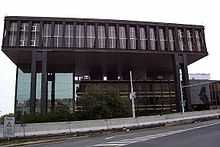Federal Assembly (Czechoslovakia)

The Federal Assembly (Czech: Federální shromáždění, Slovak: Federálne zhromaždenie) was the federal parliament of Czechoslovakia from January 1, 1969 to the dissolution of Czechoslovakia on December 31, 1992. It was Czechoslovakia's highest legislative institution.
Chapter 3 of the 1960 Constitution of Czechoslovakia recognized it as "the supreme organ of state power and the sole statewide legislative body."
The Federal Assembly was divided into two equal chambers, the Chamber of the People (Sněmovna lidu; other translation House of the People) and the Chamber of the Nations (Sněmovna národů; other translation House of Nations). The Chamber of the People reflected a system of proportional representation: in 1986 it included 134 deputies from the Czech Socialist Republic and 66 deputies from the Slovak Socialist Republic. The Chamber of Nations had 150 members, 75 from each republic. Deputies were selected through popular elections and served five year terms of office; all 350 served concurrently.
After an election each chamber met to select its own Praesidium consisting of three to six members. Together, the chambers elected the forty-member Presidium of the Federal Assembly, which served as the legislative authority when the assembly was not in session. A joint session of the Federal Assembly selected its chairman and vice chairman. Alois Indra served as chairman from 1971 to 1989.
The Federal Assembly met in regular session at least twice a year, in the spring and fall. Legislation presented to the assembly at these sessions had to be approved by both chambers and in some cases required a majority vote by both the Czech and the Slovak deputies in the Chamber of the Nations.[1]
Constitutionally, the Federal Assembly was vested with great lawmaking powers. In theory, it had exclusive jurisdiction in all matters of foreign policy, fundamental matters of domestic policy, the economic plan, and supervision of the executive branch of government. In practice, however, as in other Communist states, its function was largely confined to rubber-stamping measures placed before it by the Communist Party of Czechoslovakia (KSČ). Laws in Czechoslovakia were drafted in advance by the Presidium of the KSČ and presented to the Federal Assembly, which almost always approved them unanimously.
The democratic centralist principle extended to elections as well. Voters were presented with a single list from the National Front (Národní fronta), an all-encompassing patriotic organization dominated by the Communists. Great pressure was brought to bear on citizens to turn out at the polls, and those who dared to cross out the name of the single Front-approved candidate on the ballot risked severe reprisals. Under these circumstances, elections were almost always a formality, with the Front list winning well over 99 percent of the vote.
The Federal Assembly Building now houses the Federal Assembly National Museum. The design, by Karel Prager, is unpopular. Nevertheless, it was copied elsewhere, notably in what is now the Bank of Georgia headquarters in Tblisi.[2]
Presidents of the Federal Assembly of Czechoslovakia
- Peter Colotka January 30, 1969 - April 28, 1969
- Alexander Dubček April 28, 1969 - October 15, 1969
- Dalibor Hanes October 15, 1969 - December 9, 1971
- Alois Indra December 9, 1971 - November 29, 1989
- Stanislav Kukrak December 12, 1989 - December 28, 1989
- Alexander Dubček December 28, 1989 - June 25, 1992
- Michal Kováč June 25, 1992 - December 31, 1992
See also
- List of Presidents of the Chamber of Deputies of Czechoslovakia
- List of Presidents of the Senate of Czechoslovakia
- List of Presidents of the National Assembly of Czechoslovakia
- List of Presidents of the Chamber of the Nations (Czechoslovakia)
- List of Presidents of the Chamber of the People (Czechoslovakia)
References
- ↑ Karel Hvížďala: POLITIKA: Česko a volby prezidentů, Neviditelný pes, 19. 12. 2007
- ↑ "Pragerův federál provokuje dodnes (Prague Federal Building still controversial)" (in Czech). Portal of Prague. 26 February 2011. Retrieved 24 March 2014. Includes gallery of images.